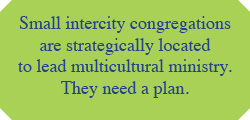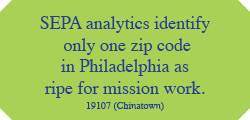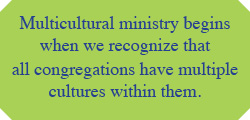How Redeemer Met the ELCA Multicultural Ministry Goal
In our last post we noted that Redeemer Lutheran Church in East Falls had achieved the goal of expanding multicultural ministry. The national church recognized our success, but the regional church (SEPA Synod) totally disregarded our ministry.
At the last National Assembly, the leaders of our church reported poor progress on meeting this goal nationwide. We think Redeemer’s experience can shine some light on why these goals are not being met.
There are at least three roadblocks:
1. Regional bodies are not comfortable with the goal.
 There seems to be no infrastructure for implementing this major change in the denomination. When it comes to multicultural ministry, most churches and leaders are experimenting. Many of the smallest churches are strategically located in neighborhoods with the most potential for multicultural ministry, but they have the least help in achieving this important goal and may very well be on a synod’s endangered list.
There seems to be no infrastructure for implementing this major change in the denomination. When it comes to multicultural ministry, most churches and leaders are experimenting. Many of the smallest churches are strategically located in neighborhoods with the most potential for multicultural ministry, but they have the least help in achieving this important goal and may very well be on a synod’s endangered list.
Regional bodies have a tendency to cripple congregations with labels. They see congregations in terms of the past. Congregations, led by professional leaders who are familiar with those names, have a hard time ministering beyond low expectations. Regional bodies are unconsciously saying NO to the potential for multicultural outreach by failing to provide leaders for neighborhoods experiencing cultural change. Caretaker pastors will ignore the cultural changes happening all around the congregation as they hold the hands of existing members, waiting for them to die. When regional bodies lose these neighborhood outposts, they lose valuable assets for achieving their goal of multicultural ministry.
What would happen if synods approached neighborhood churches with high expectations and gave them the help they needed to reach them?
Redeemer did not set out with multicultural ministry as our objective. We just welcomed all who came to our door. This was met with resistance from SEPA leadership, who had predetermined that slow death was to be our fate.
The first Tanzanian family who came to Redeemer in 1998 asked for their two infant sons to be baptized. Bishop Almquist had declared synodical administration. We were advised to NOT baptize the children or encourage new membership. (They had NOT declared us closed but that’s what they had in mind!) The family shared only recently that a synod representative had visited them and discouraged them from joining Redeemer, which was only a few blocks from their home. “Why do you want to join a church with no black members?” they were asked. They suggested they join a church with black members several neighborhoods away.
This family joined Redeemer anyway. They were to play an important role in Redeemer’s multicultural future.
2. Pastors are not comfortable in multicultural ministry.
 As this family became active, they often expressed the desire to reach out to more of the East African immigrant community. Extended family and friends began joining. One was active in social work near our church and wanted to expand outreach to nearby Hispanic neighborhoods. This ministry direction had been discussed often at council meetings with our pastors, who admitted they were not equipped to lead this type of ministry. We asked them to help us find extra help. The report was always the same. “There is no one.” Redeemer wanted to move in a direction professional leadership was unable or unwilling to take us.
As this family became active, they often expressed the desire to reach out to more of the East African immigrant community. Extended family and friends began joining. One was active in social work near our church and wanted to expand outreach to nearby Hispanic neighborhoods. This ministry direction had been discussed often at council meetings with our pastors, who admitted they were not equipped to lead this type of ministry. We asked them to help us find extra help. The report was always the same. “There is no one.” Redeemer wanted to move in a direction professional leadership was unable or unwilling to take us.
Within weeks of our last pastor’s resignation, lay members had identified two qualified Lutheran pastors with roots in East African culture who were willing to visit and invite. Within a few months, Redeemer had 49 new members. During this time, SEPA leadership totally ignored us. They had no interest in helping a church they perceived as dying. When we sent a resolution to Bishop Burkat to call one of the pastors who had been working with us for seven months, she declared Redeemer closed.
3. Congregations are not comfortable with multicultural ministry.
Congregations naturally will wonder what will become of their culture if you open the door to other cultures. Redeemer faced this challenge, too.
 First, we made sure that veteran members were not neglected and were active in welcoming. The church service became a bit longer with the incorporation of other languages and music, but the old membership did not have to forsake cherished traditions. Strangers were not valued more than they. God’s love grows community; it does not neglect one community to lavish attention and resources on another.
First, we made sure that veteran members were not neglected and were active in welcoming. The church service became a bit longer with the incorporation of other languages and music, but the old membership did not have to forsake cherished traditions. Strangers were not valued more than they. God’s love grows community; it does not neglect one community to lavish attention and resources on another.
In light of these three roadblocks, the ELCA has set a goal which few people share except in theory. Here is advice from our experience on how to detour these roadblocks.
Invite.
Being invitational must be taught not just preached. Pastors often say this is the congregation’s job, but in today’s climate it must start with the pastor. The pastor must model this for the congregation, especially if a congregation has been suffering. Members will be of low morale and unable to invite. Pastors should visit, talk enthusiastically about their visits, encourage members to come along, and make sure there are quality offerings for members to promote with enthusiasm. This will rebuild invitational confidence.
Don’t cut the roots.
Popular advice from church hierarchy touts allowing churches to die so that Christian community can be “resurrected.” This is a distortion of the Resurrection message. The Bible does not advocate evicting the faithful to invite new members. As cheery as this may sound, it is cruel in practice. Time will tell if these theories have longevity or if their cited successes are flashes in the pan.
We suspect the Church will not grow if you cut the roots. If veteran members are ignored, criticized, and evicted, the neighborhood will notice. Sensitive new members will ask themselves if one day this will be their fate. Make sure that old members are part of the process of welcoming new members. Change may be desirable but keep some things the same. New members will know that they are influencing a new chapter in a long tradition.
Ministry is not multicultural if cultures never mix.
Redeemer began by offering a separate service for East Africans, but this lasted only a few months. Both “old” Redeemer and “new” Redeemer wanted to be in communion. Some congregations never move beyond this and become two congregations sharing the same building while calling it multicultural.
We faced the challenge of merging communities with FOOD.
Many churches have coffee hour. It was our observation that coffee hour does not create true fellowship. People grab their styrofoam cup and find a corner to talk to people they already know.
We began serving soup. One pasta pot of soup brought in from home will feed a small church fellowship. Easy to serve; easy to clean up. Soup encourages people to sit down together. Soup is multicultural. “Old” Redeemer tasted “banana” soup, a Tanzanian staple. A Puerto Rican vicar introduced us to sancocho beef stew — “not spicy, just tasty.” If conversation stalled, we talked about the soup, asking who made the soup and what was in the soup. Stories followed about how mother made the soup, how spices were chosen . . . and suddenly you have a proud congregation sharing traditions.
When the arts are explored, minds open.
We wanted the message that our congregation was welcoming to all cultures to be clear. It’s hard to change the stained glass windows, but we featured art and poetry from different cultures on our bulletins. We occasionally practiced the Taize traditions with icons and chants. Liturgical dance became part of our tradition. Drums were played by members sitting in the pew, but the church organ still whined away. Some of the art/music featured was traditional. We did not replace what was dear to people. We added to it.
Use the gift of language.
Foreign languages make Americans nervous. Our new members graciously recognized this and switched to English when others were present. It was a considerate, unsolicited gesture that helped create community.
In worship we alternated languages between verses in singing hymns. We said the Lord’s prayer in Swahili and English until Swahili-speaking members objected, saying God needs to hear our prayers in only one language. English-speaking Redeemer objected, saying “But we need to hear it in Swahili.” We didn’t debate; we alternated.
Soon, English-speaking Redeemer began adopting Swahili phrases in conversation.
Which brings us to our final point for today.
Be flexible.
In one way of thinking all churches are multicultural. Concentrating on the multicultural in ministry is forging new ground. Develop a welcoming atmosphere and follow your instincts.
If you’d like a team from Redeemer to make a presentation on our multicultural experience, please leave a comment and we will get back to you.
